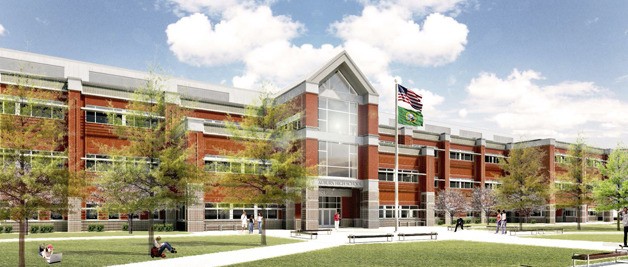For a 61-year-old school built in haste after the 1949 earthquake flattened its predecessor, Auburn High School looks to be in good shape.
From the outside, that is.
But the black smoke that streamed out of a malfunctioning, ancient boiler last week, forcing students out, hints at the grim reality beneath the surface. Peel the building’s skin back, district officials say, and you’ll find infrastructure long past its prime, leaking roofs and outdated fire suppression systems, and archaic heating, cooling and ventilation systems dating to the Truman administration.
The upshot — students all too often left to shiver in cold classrooms, as they did Tuesday when the old boiler went on the fritz again.
Keeping the high school going, district officials say, sucks up too money.
“Right now, we spend more on just maintaining Auburn High School then we do all our other high schools combined. We don’t have good energy efficient systems, the walls were not built for insulation, the windows aren’t of the factor to save energy,” said Auburn School District Superintendent Kip Herren, adding that the combined bill is about $250,000 more per year than the other schools, a sum that comes out of other programs, not out of a capital bond account.
“People don’t know,” Herren added, “that Auburn High School is falling apart on the inside. … The bones weren’t built to go over 60 years old.”
The school district and a community steering committee recently completed an in-depth assessment of the aging building and found that it would longer be cost effective to remodel it. Not only is it in disrepair and too costly operate and maintain, it also fails to meet many of the school district’s facility standards.
The school district board, keenly aware of the problem, has approved putting before voters Feb. 14 an Auburn High School modernization and reconstruction bond package and an educational programs and operations replacement levy package.
The Auburn High School Modernization and Reconstruction Bond proposal asks $110 million for the project. Funds from the bond sale, added to $10 million from the school district’s Capital Projects Fund, will finance the modernization and reconstruction of the high school.
A $239 million bond measure, that would have funded not only a new high school but upgrades at Olympic Middle School and at Terminal Park and Pioneer elementaries, failed in 2008, just as the economy went south. This time, the bond is only about new high school construction.
The four-year replacement levy will maintain current educational programs and services for all children including small class size, instructional programs, special education, athletics and activities, transportation, and maintenance and custodial services. This replacement levy is not a new tax. It replaces the expiring 2008 levy and is required to maintain current instructional programs and services.
Herren said the combined passage of the levy and bond will result in level school taxes for the average homeowner in Auburn. He said the modernization and reconstruction bond will fund critical improvements at AHS while keeping school taxes level.
Auburn High has been expanded five times since its construction in 1950.
Over the past 10 years, the school district has established a surplus in the Capital Projects Fund through careful management of its building construction program. The surplus funds will be used to help finance the Auburn High School project and will ultimately reduce the tax impact on citizens.
If the bond issue passes in February 2012, construction would start in 2013 and be completed in 2015.
====
Plan for Auburn High School
The modernized and reconstructed Auburn High School would:
• Replace all of the buildings on campus except for the PAC (Performing Arts Center) and Auto Shop.The PAC, Auto Shop and grounds will be modernized.
• The new facility will be similar in size and student capacity to the current school.
• The building will be brick with a classic and timeless appearance.
• Offer a front entry on East Main Street, no longer on 4th Street.
• Be built at its current location in phases so students can safely remain on campus during the project.
• Improve heating, cooling and ventilation.
• Include seismic upgrades.
• Be under one roof with two points of entry, instead of 81, which is now the case.
• Increase student safety.
• Have off-street bus loading areas.
• Provide new classrooms and building technology.
• Increase on-site parking from 300 to 600 stalls.
• Include a large student commons and new synthetic turf baseball and softball fields.
• Improve access for the disabled.
• Include a large parking lot adjacent to the PAC, pool and main gym directly across from Auburn Memorial Stadium.
====
For more details, visit www.auburn.wednet.edu/Levy/Levy_Bond.html


